World History
 |
 |
 |
 |
 |
 |
 |
The Jacobites: A Heroic but Failed Mission
Recently, a reader, who noticed we have posted several Jacobite songs (here and
here), made an inquiry about our opinion of the Jacobite cause of Scotland and of the Stuarts dynasty in general.
First I will address the question of who were the Stuarts, and then go on to discuss the Jacobite cause.
The Stuarts rose to power in Scotland in the early 15th century and reigned for nigh 300 years. Trouble for the dynasty began in the 1530’s with the reign of King Henry VIII of England, whose apostasy brought conflict between the Tudors and Stuarts.
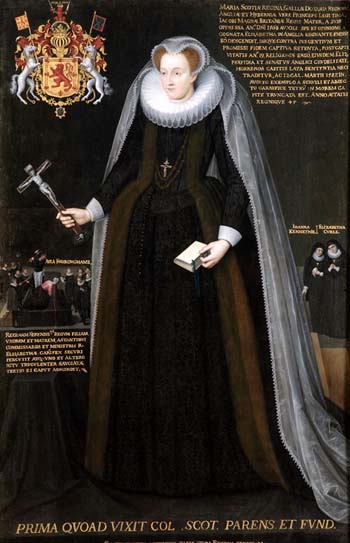 Shortly before the ascension of Queen Elizabeth I to the English throne, Mary, Queen of Scots, the eighth Stuart monarch, was born amid the budding turmoil of the Protestant Revolution, when most of Scotland had apostatized. She was the only child of King James V, a good Catholic who protected the rights of the Church and fought against heresy. Her birth came only a week after his death in 1542.
Shortly before the ascension of Queen Elizabeth I to the English throne, Mary, Queen of Scots, the eighth Stuart monarch, was born amid the budding turmoil of the Protestant Revolution, when most of Scotland had apostatized. She was the only child of King James V, a good Catholic who protected the rights of the Church and fought against heresy. Her birth came only a week after his death in 1542.
Growing up amid a court of bad Protestant advisors, Queen Mary, although a devout Catholic herself, made some concessions to Protestantism that would have consequences in the life of her son.
After her first husband, the French Dauphin, died in 1560, she married Lord Darnley, who, although a Catholic, had a very unworthy character. It was through this union that a son was born to Mary, the boy who would grow up to become King James VI of Scotland and I of England, the first King to unite the two thrones, formally at bitter odds with one another.
However, he was taken as a baby from his mother after her forced abdication of the throne and raised to have Protestant convictions. Sadly, he was more concerned about ascending to the throne of England than saving his mother from her execution at the hands of her Cousin Elizabeth I. James was a peaceable Protestant King, who tolerated Catholics but did not hold to the Faith, so strongly and heroically professed by his mother at her death. (1)
Thus, the union achieved by the two warring nations is not one to be praised, for it was gained by King James’ denial of his Catholic heritage, since only a Protestant would be tolerated on the thrones of both England and Scotland. His two successive heirs, Charles I and Charles II, while upholding the Protestantism of their courts, tolerated and at times even seemed to favor Catholics.
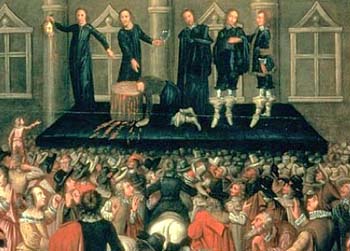 Charles I was executed during Cromwell’s Puritanical Revolution. After Cromwell’s death, Charles I’s son, Charles II, was reinstated as King in May 1660. Charles II, though in many ways a bad King, converted to Catholicism at the end of his life, at perhaps the same time as his younger brother, James, who publicly declared his profession of the True Faith in 1671. His conversion would spark the rise of the valiant movement of the Jacobites.
Charles I was executed during Cromwell’s Puritanical Revolution. After Cromwell’s death, Charles I’s son, Charles II, was reinstated as King in May 1660. Charles II, though in many ways a bad King, converted to Catholicism at the end of his life, at perhaps the same time as his younger brother, James, who publicly declared his profession of the True Faith in 1671. His conversion would spark the rise of the valiant movement of the Jacobites.
The year 1685 marked the death of Charles II and the succession of James II to the thrones of Scotland and England. As his brother before him, James II had a strong connection with the French court, a friendship that most likely contributed to the conversion of both Kings.
Although Scotland, when Catholic, had boasted its “auld alliance” with France, England regarded France as one of her most bitter enemies. Thus, the now Protestant Scotland and England found in James II a great reason for dissension.
Yet the greatest cause of concern for Parliament regarding James was his Roman Catholicism. A strong Catholic they could not abide on the throne, and even more so could they not abide a Catholic heir, who was born to James in 1688. Thus, just months after the birth of his son, James was forced to go into exile.
This would mark the event known as the “Glorious Revolution” – a bloodless revolution that overthrew a Catholic King and crowned instead a Protestant, William of Orange, the husband of James’ eldest daughter Mary, who ruled Holland at that time. William and Mary both signed the revolutionary Bill of Rights, in which Catholics were forbidden to be kings or queens and the principle of the Divine Right of monarchs was completely overthrown.
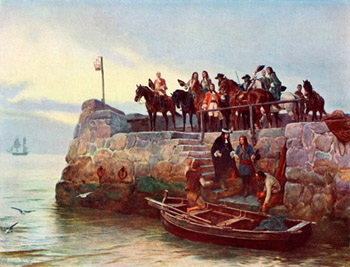 Though their true King was taken from them, many Scots, Irish, and Englishmen remained loyal to their exiled King. These loyal men and women became known as the Jacobites, because they supported the sovereignty of James II and, eventually, of his son James, Prince of Wales.
Though their true King was taken from them, many Scots, Irish, and Englishmen remained loyal to their exiled King. These loyal men and women became known as the Jacobites, because they supported the sovereignty of James II and, eventually, of his son James, Prince of Wales.
All the Catholic monarchs of the time refused to acknowledge William and Mary as King and Queen, instead supporting James II as the rightful monarch. Even the Irish Parliament did not accept William of Orange, and King James marched with the Irish and some French troops to do battle with the usurper.
This attempt failed with the defeat of James and the Irish at the Battle of Boyne in 1690. Upon the death of James II, the Catholic Heads of State as well as the Vatican declared his son to be King James III.
James, known as the Old Pretender, led an uprising in 1715 against George I of England, grandnephew of Charles I and first Hanoverian King from Germany. This rising was a failure and crushed the hopes of the Old Pretender, who returned to France. The Jacobites, however, continued to cause trouble for the foreign King.
‘Bonnie Prince Charlie’
The idealism of a young Prince raised the spirits of the Jacobites when Bonnie Prince Charlie, the son of James, returned to Scotland to reclaim his father’s throne. His courage and personality attracted the clans to him at a time when they were on the verge of giving up, and he led a glorious uprising that will never be forgotten.
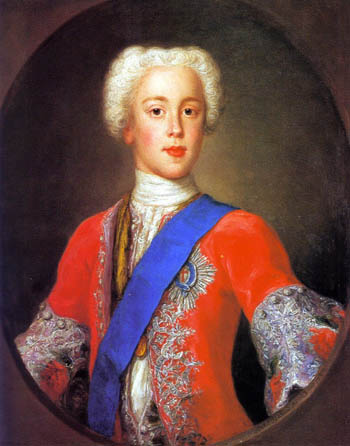 On Charles’ arrival in Scotland, MacDonald of Boisdale, having little hope in the Jacobite cause, urged the Prince to return home. But the brave Prince replied, “I am come home.”
On Charles’ arrival in Scotland, MacDonald of Boisdale, having little hope in the Jacobite cause, urged the Prince to return home. But the brave Prince replied, “I am come home.”
And so he was, home at last on the land that had belonged to his forefathers, to reclaim a lost throne so unjustly taken over by Protestant foreigners.
Bonnie Prince Charlie led his Highlanders to conquer Edinburgh in a great victory; then he led them to the outskirts of London. His valor and battle cunning would have led him into the heart of that great city, but his advisors were against the risks they could face by attacking London. To the strong objection of Charles, the Jacobites retreated back to the Highlands, a decision that led to the defeat and utter ruination of the Prince’s army.
The infamous Battle of Culloden was fought on April 15, 1746, in which hungry, tired, disillusioned Jacobites were slaughtered by the well-equipped and well-fed English army. Prince Charles was forced to flee.
Once a hero now a hunted outlaw, he managed to escape to the Island of Skye with the help of Flora MacDonald, who dressed him as a maid and rowed him across the water to safety. From there, he was able to board a ship bound for France. Later he went to Rome, where he died in 1788, at the age of 67.
Hope for Britain's return to the Catholic Faith
The tragic story of the Jacobite cause ensued. Any remaining Jacobites were hunted down, killed, imprisoned or sold as slaves to American plantations. The Revolution understood well the importance of customs and symbols, and so the wearing of tartans and kilts, the playing of the bagpipes, and the owning of weapons were all outlawed for Highlanders.
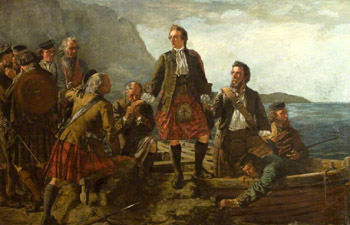 In this way, the Jacobite spirit was crushed and smothered. The hope for the restoration of Britain to the Catholic Faith, so briefly reignited, was extinguished.
In this way, the Jacobite spirit was crushed and smothered. The hope for the restoration of Britain to the Catholic Faith, so briefly reignited, was extinguished.
Many Jacobites fled to America, where they played an interesting part in American History that will be discussed in a later article.
In conclusion, the Jacobite cause was a noble Catholic Cause whose adherents fought for the rightful heir to the English and Scottish thrones, so rudely overthrown by a Protestant Whig Parliament. It represented the one hope that Britain had to return to the Catholic Faith. And what a great restoration it would have been had Bonnie Prince Charlie and his Jacobites succeeded.
But just as the Spanish Armada was defeated before it was able to bring an end to Elizabeth’s tyrannical rule, so were James and Prince Charles defeated before they could bring the light of the True Faith back to the English and Scottish peoples. It is a mystery in the annals of human History. Yet, because we believe in God’s infinite Wisdom, we know that there is a reason for both attempts having failed.
Perhaps in the Reign of Mary, Britain will at last see the grand Restoration for which the Jacobites fought.
Indeed, we can unite our plea with that of the Jacobites, who so poetically expressed their longing for the return of their dear Prince in this heart-rending song:
“Sweet’s the laverock’s note and lang,
Lilting wildly up the glen;
But aye to me he sings ae sang,
Will ye no come back again?”
Even so do we long for the time when our Holy Faith will return to the Lowlands and Highlands of the Isle of Saints.
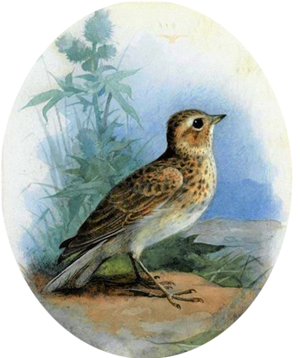

First I will address the question of who were the Stuarts, and then go on to discuss the Jacobite cause.
The Stuarts rose to power in Scotland in the early 15th century and reigned for nigh 300 years. Trouble for the dynasty began in the 1530’s with the reign of King Henry VIII of England, whose apostasy brought conflict between the Tudors and Stuarts.

Mary Queen of Scots, who died at the order
of her cousin Elizabeth
Growing up amid a court of bad Protestant advisors, Queen Mary, although a devout Catholic herself, made some concessions to Protestantism that would have consequences in the life of her son.
After her first husband, the French Dauphin, died in 1560, she married Lord Darnley, who, although a Catholic, had a very unworthy character. It was through this union that a son was born to Mary, the boy who would grow up to become King James VI of Scotland and I of England, the first King to unite the two thrones, formally at bitter odds with one another.
However, he was taken as a baby from his mother after her forced abdication of the throne and raised to have Protestant convictions. Sadly, he was more concerned about ascending to the throne of England than saving his mother from her execution at the hands of her Cousin Elizabeth I. James was a peaceable Protestant King, who tolerated Catholics but did not hold to the Faith, so strongly and heroically professed by his mother at her death. (1)
Thus, the union achieved by the two warring nations is not one to be praised, for it was gained by King James’ denial of his Catholic heritage, since only a Protestant would be tolerated on the thrones of both England and Scotland. His two successive heirs, Charles I and Charles II, while upholding the Protestantism of their courts, tolerated and at times even seemed to favor Catholics.

King Charles I was publicly beheaded at an order from Parliament, a plot instigated by Cromwell
The year 1685 marked the death of Charles II and the succession of James II to the thrones of Scotland and England. As his brother before him, James II had a strong connection with the French court, a friendship that most likely contributed to the conversion of both Kings.
Although Scotland, when Catholic, had boasted its “auld alliance” with France, England regarded France as one of her most bitter enemies. Thus, the now Protestant Scotland and England found in James II a great reason for dissension.
Yet the greatest cause of concern for Parliament regarding James was his Roman Catholicism. A strong Catholic they could not abide on the throne, and even more so could they not abide a Catholic heir, who was born to James in 1688. Thus, just months after the birth of his son, James was forced to go into exile.
This would mark the event known as the “Glorious Revolution” – a bloodless revolution that overthrew a Catholic King and crowned instead a Protestant, William of Orange, the husband of James’ eldest daughter Mary, who ruled Holland at that time. William and Mary both signed the revolutionary Bill of Rights, in which Catholics were forbidden to be kings or queens and the principle of the Divine Right of monarchs was completely overthrown.

King James fleeing after the invasion of William of Orange
All the Catholic monarchs of the time refused to acknowledge William and Mary as King and Queen, instead supporting James II as the rightful monarch. Even the Irish Parliament did not accept William of Orange, and King James marched with the Irish and some French troops to do battle with the usurper.
This attempt failed with the defeat of James and the Irish at the Battle of Boyne in 1690. Upon the death of James II, the Catholic Heads of State as well as the Vatican declared his son to be King James III.
James, known as the Old Pretender, led an uprising in 1715 against George I of England, grandnephew of Charles I and first Hanoverian King from Germany. This rising was a failure and crushed the hopes of the Old Pretender, who returned to France. The Jacobites, however, continued to cause trouble for the foreign King.
‘Bonnie Prince Charlie’
The idealism of a young Prince raised the spirits of the Jacobites when Bonnie Prince Charlie, the son of James, returned to Scotland to reclaim his father’s throne. His courage and personality attracted the clans to him at a time when they were on the verge of giving up, and he led a glorious uprising that will never be forgotten.

The young Charles revived the courage and hope of the Jacobites
And so he was, home at last on the land that had belonged to his forefathers, to reclaim a lost throne so unjustly taken over by Protestant foreigners.
Bonnie Prince Charlie led his Highlanders to conquer Edinburgh in a great victory; then he led them to the outskirts of London. His valor and battle cunning would have led him into the heart of that great city, but his advisors were against the risks they could face by attacking London. To the strong objection of Charles, the Jacobites retreated back to the Highlands, a decision that led to the defeat and utter ruination of the Prince’s army.
The infamous Battle of Culloden was fought on April 15, 1746, in which hungry, tired, disillusioned Jacobites were slaughtered by the well-equipped and well-fed English army. Prince Charles was forced to flee.
Once a hero now a hunted outlaw, he managed to escape to the Island of Skye with the help of Flora MacDonald, who dressed him as a maid and rowed him across the water to safety. From there, he was able to board a ship bound for France. Later he went to Rome, where he died in 1788, at the age of 67.
Hope for Britain's return to the Catholic Faith
The tragic story of the Jacobite cause ensued. Any remaining Jacobites were hunted down, killed, imprisoned or sold as slaves to American plantations. The Revolution understood well the importance of customs and symbols, and so the wearing of tartans and kilts, the playing of the bagpipes, and the owning of weapons were all outlawed for Highlanders.

‘Bonnie Prince Charlie’ with the Jacobites who supported his noble cause
Many Jacobites fled to America, where they played an interesting part in American History that will be discussed in a later article.
In conclusion, the Jacobite cause was a noble Catholic Cause whose adherents fought for the rightful heir to the English and Scottish thrones, so rudely overthrown by a Protestant Whig Parliament. It represented the one hope that Britain had to return to the Catholic Faith. And what a great restoration it would have been had Bonnie Prince Charlie and his Jacobites succeeded.
But just as the Spanish Armada was defeated before it was able to bring an end to Elizabeth’s tyrannical rule, so were James and Prince Charles defeated before they could bring the light of the True Faith back to the English and Scottish peoples. It is a mystery in the annals of human History. Yet, because we believe in God’s infinite Wisdom, we know that there is a reason for both attempts having failed.
Perhaps in the Reign of Mary, Britain will at last see the grand Restoration for which the Jacobites fought.
Indeed, we can unite our plea with that of the Jacobites, who so poetically expressed their longing for the return of their dear Prince in this heart-rending song:
“Sweet’s the laverock’s note and lang,
Lilting wildly up the glen;
But aye to me he sings ae sang,
Will ye no come back again?”
Even so do we long for the time when our Holy Faith will return to the Lowlands and Highlands of the Isle of Saints.

The laverock, or lark
- To know the details of the last months of Mary Stuart, we highly recommend reading the book The Tragedy of Fotheringay by Hon. Mrs.Mary Monica Maxwell-Scott.
- Other Sources:
https://www.newworldencyclopedia.org/entry/James_II_of_England
https://www.history.co.uk/biographies/charles-ii
https://spanishstepsapartment.wordpress.com/2015/06/14/exiled-royals-in-rome/
Highlanders by Fitzroy Maclean, published by Viking Penguin in 1995
The Kings and Queens of England and Scotland by Plantagenet Somerset Fry, published in 1990

Posted March 19, 2021
______________________
______________________





